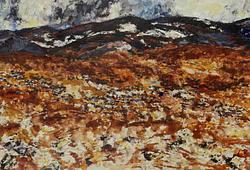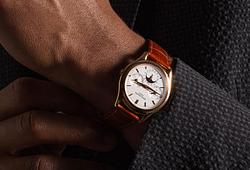Important Winter Sale presents a masterpiece by John Bauer
In 1912, the artist John Bauer was at the peak of his career. His art was exhibited both in Sweden and abroad. During this period, he painted one of his most significant works, “Sagoflickan,” a painting on canvas in a monumental format for Bauer, measuring 136 x 140 cm. The inspiration for the girl sitting on a moss-covered stone and combing her long hair was drawn by Bauer from his beloved wife Ester as well as from the Marian figures of the Italian Renaissance. “Sagoflickan” has been exhibited at several important exhibitions both in Sweden and abroad, including Konstnärshuset, Stockholm, 1913, The Panama-Pacific International Exposition, San Francisco, 1915, the touring exhibition “The Swedish Exhibition,” 1916, and the Royal Academy of Fine Arts, Stockholm, 1934, cat. no. 192.
Exhibited and Celebrated
After John Bauer painted “Sagoflickan” in 1912, it was exhibited the following November at Konstnärshuset. He exhibited alongside his colleague Sigge Bergström, and in Aftonbladet’s review, the critic pointed out “Sagoflickan” as “captivating in colour and form” in its larger dimensions. In 1915, Dagens Nyheter highlighted “Sagoflickan” in both text and image in their reportage on the World’s Fair in San Francisco, also known as The Panama-Pacific International Exposition. The purpose of the exhibition was to celebrate the completion of the Panama Canal, which had opened in 1914. The exhibition also became an opportunity for the city to showcase its recovery after the great earthquake of 1906. Ferdinand Boberg was hired as the architect for the Swedish pavilion, and Anshelm Schultzberg as the commissioner for Swedish art. Dagens Nyheter’s report begins with three images: a photo of the art hall, one of Schultzberg, and a photo of the painting “Sagoflickan.” The reporter writes: “This, our outstanding fairy-tale illustrator, has already been recognised as one of the most remarkable exhibitors in the entire art palace. Even the prosaic Americans are enchanted by Bauer’s art.” He continues to praise the painting: “One can hardly get enough of his Sagoflickan in oil or the score of fairy-tale drawings he has here […]”. Schultzberg explains in the report that the great interest in Swedish art had led the commissioner to take it on a traveling exhibition that came to be called “The Swedish Exhibition” the following year.

On 20 May 1918, newspapers proclaimed that “Sagoflickan” had been sold at the “Cirkeln Artists’ Exhibition.” Bauer’s wife Ester had earlier discussed the sale in a letter that month and lamented the high commission Cirkeln had taken. Of the 4,500 kronor it was sold for, Cirkeln, according to the letter, had kept 900 kronor. In November of the same year, Bauer tragically died in a boat accident along with his wife and child, and in 1919 Cirkeln held a memorial exhibition for the artist. “Sagoflickan” was exhibited here as well, and Svenska Dagbladet chose to depict it in their review of the exhibition.
Nature Mysticism and Mythical Creatures
“Sagoflickan” was painted during a time marked by a fascination with magical nature and mythical creatures from folklore. This interest in the mystique of nature can be explained against the backdrop of rapid societal changes occurring around the turn of the 20th century. In a transformative period characterised by industrialisation, modernity, and science, artists, writers, and composers turned their gaze towards the shadowy aspects of existence and the mysteries of nature. The myths about evil and ugly trolls and beautiful forest spirits and fairies had been passed down orally for centuries through folklore, ballads, and legends. These nature spirits were seen as an integral part of life at the time. What could not be understood or was considered deviant from the norm was often explained by the involvement of these nature beings in people’s lives.
This zeitgeist was widespread in Stockholm when Bauer moved there in 1898 to study at the Academy of Fine Art. He grew up in Jönköping in the late 19th century. His father was a hunter, and together they spent much time in the forests of Småland, something that made a strong impression on the young Bauer. In 1900, Bauer was accepted into the Academy of Fine Art and became early interested in the art of illustration. By 1903, he was already considered an established illustrator, for example through his drawings for Anna Wahlberg's fairy tale collection Länge, länge sedan, for which Bauer designed the cover and made 26 illustrations. Over the following years, he developed his style and motifs. He found the deep forest where gnarly trolls and delicate fairies and princesses lived among mossy stones and tall trees.
In 1907, he was commissioned to illustrate Bland tomtar och troll, an annual edition of collected fairy tales. Through his images, he would shape our perception of the fairy-tale forest and its inhabitants. The forest became his stage, and he filled it with beautiful princesses and peculiar trolls. John Bauer settled with his wife Ester Ellqvist in Torstorp outside Gränna, where the artist could wander the dense forests and find inspiration for his visual world. He writes in a letter: "God, how the stars twinkle and sparkle. The ice roars, and the earth is black." (From a letter from John Bauer to Carl Edvard Berggren, Gränna, Torstorp, 16 January 1907, JLM: John Bauer archive, no. 677).

Bauer's Fairy-Tale Girl
The fairy-tale princess was a recurring protagonist in Bauer's visual world. In The Tale of Dag and Daga and the Flying Troll on Skyberget from the 1907 edition of Bland tomtar och troll, we follow the fairy-tale princess on her journey through the forest. The tale goes: “With the gold crown on her head and dressed in a white gown, she walked there under the tall, sombre spruce trees.” Bauer illustrated the ethereal princess, whose light and beauty contrast with the dark depths of the forest. This contrast between dark and light is a recurring theme in Bauer’s images, where the ugly trolls belong to the primordial nature, while the princess represents the otherworldly and the beautiful. The inspiration for the princess’s figure was his wife Ester, whom he first met during their time as students at the Academy of Fine Art, where they were both pupils. Even during their school years, he painted her in the work The Fairy-Tale Princess, and she would later model for several of Bauer's illustrations. He writes to her in a letter in 1905: "I have placed you so high, Esther. And up there is where I want you to stay."
Over the years, Bauer's princesses began to take on a new form. Bauer and Ester travelled to Italy in 1908–1909, a journey that would be decisive for the artist. In the book John Bauer – The Fairy-Tale Illustrator from 1942, the artist’s biographer Harald Schiller suggests that it was in Italy where Bauer fully liberated “the personal and original aspects of his art.” In Italy, he worked on his second edition of Bland tomtar och troll, and in this, one can see how the Early Renaissance art he saw in Florence left clear traces in his visual world. In the tale The Swan Maiden from the 1908 edition, Schiller observes how Bauer's characters had become Florentine men and women, “not only in posture and appearance but also in costume.” He continues to explain how Bauer combines the southern with the northern: “It is not Italy’s stiff pines and fertile landscapes, but a romantic Småland scene with yellow birches and wistfully distant blue hills that forms the background."
In the fourth edition of Bland tomtar och troll in 1910, the fairy-tale princess is still a version of his wife Ester, but now somewhat more stylised and idealised, resembling the Madonna figures he had seen in Renaissance paintings in Italy. Schiller sees in Bauer’s princesses from this period “a lateborn relative of Ghirlandaio’s and Botticelli’s fair, delicate, and slender virgins.” The fairy-tale princes had also now become Florentine youths, dressed in ancient Nordic costumes with jewellery and weapons. Thus, Bauer’s fairy-tale world had acquired its permanent figures, and after the 1910 edition, his apprenticeship was over. When he next illustrated Bland tomtar och troll in 1912, as Schiller writes, he had become a master.
Monumental Painting
Schiller writes: "It was only with the 1912 fairy tale collection that Bauer cast aside his caution and created illustrations where colour played a decisive role. But year by year, one can observe how he is drawn towards the problem of colour, with increasingly bold use of yellow, and at times also blue, moving towards stronger colour harmonies." As the colours became bolder, the forms became more stylised and refined. His treatment of stones and cliffs became less monotonous and more rooted in a thorough study of nature, with increasingly detailed patches of lichen and moss.
At the same time as he continued to produce illustrations during this period, he also began to paint on a large scale. Early in his career, he had painted large works and had gained attention for it. His professor at the Academy of Fine Art, Gustaf Cederström, had recognised his talent and encouraged him to take on fresco painting, a classical mural technique. Now, Bauer rekindled his interest in large-scale painting, of which "Sagoflickan" is an early example. Critics had noted a monumental ambition in some of his earlier illustrations and were therefore not surprised by this new direction. Andreas Lindblom wrote about this in Svenska Dagbladet in 1919, where he mentioned the painting currently at auction: "John Bauer's final years were remarkable for new ideas. It would have been unnatural if such a strong character had, for more than a decade, been content with the illustration style he had already mastered. We suddenly encounter some large compositions again, such as 'Sagoflickan' and 'Freja'. The former is a book illustration en gros, a testament to how monumentally many of these small pieces are conceived. (As an aside, it would be extremely interesting to see these fairy tale pictures through a lantern projector. Many would hold up as frescoes!)".
"Sagoflickan" has been in private ownership since its sale at Cirkeln, the Artists' Sales AB in Stockholm, in 1918.

The work is being sold at Important Winter Sale
Estimate 7 000 000 – 8 000 000 SEK
Catalogue online November 27, 2024
Visning December 5 – 10, Berzelii Park 1, Stockholm
Liveauktion December 11 – 13, Arsenalsgatan 2, Stockholm
Read more about Important Winter Sale
Requests & condition reports

Tukholma
Andreas Rydén
Varatoimitusjohtaja, Johtava asiantuntija, taide
+46 (0)728 58 71 39

Tukholma
Lena Rydén
Johtava taideasiantuntija, moderni- ja 1800-luvun taide
+46 (0)707 78 35 71

Tukholma
Mark Sjöberg
Asiantuntija taide & taidegrafiikka
+46 (0) 707 88 84 72



























